Deputy Minister transition binder 2023: Environmental Protection
Key elements
- Monitoring, preventing and managing pollution from all its various sources.
- Preventing and reducing air and water pollution.
- Managing the risks from chemical substances.
- 24/7 scientific & technical support to environmental emergencies.
- Ensuring hazardous waste is properly managed / safely disposed.
- Reducing GHG emissions.
- Shared jurisdiction with provincial and territorial governments.
- Collaborative mechanisms include Canadian Council of Ministers of the Environment, Canadian Environmental Protection Act National Advisory Committee, and other issue-specific engagements.
- ECCC has strong reputation for regulatory excellence, produces high volume of regulatory initiatives based on:
- Science-based initiatives.
- Extensive engagement and collaboration.
- Transparency.
- Outcomes-based risk management measures.
Legislation framework
- Key environmental protection Acts provide authority to manage risks to the environment and human health from pollution:
- Canadian Environmental Protection Act, 1999 (CEPA).
- Fisheries Act (pollution prohibition).
- Migratory Birds Convention Act (MBCA) (pollution prohibition).
- Greenhouse Gas Pollution Pricing Act (GGPPA).
- Impact Assessment Act (IAA).
- Antarctic Environmental Protection Act.
- Legislation or regulation must be linked to an appropriate constitutional head of power, for example:
- Criminal law.
- Sea coast and inland fisheries.
- Ability to make laws for peace, order and good government of Canada.
Pollution overview
Canadians have clean air
Air pollution is the single largest environmental risk to human health; it degrades the environment and can reduce economic productivity.
Pollution of all kinds disproportionately impacts Indigenous Peoples and marginalized communities.
Context
- In Canada, air pollution contributes to ~15,300 early deaths and $120B in health costs every year
- Results in reduction of crop yields and costs our farmers hundreds of millions in lost production
- Although 5 of 6 key pollutants decreased by 18-65% since 1990, ambient levels of smog pollutants have plateaued in recent years and are expected to worsen
Percentage change in Canada air pollutant emissions (1990-2020)
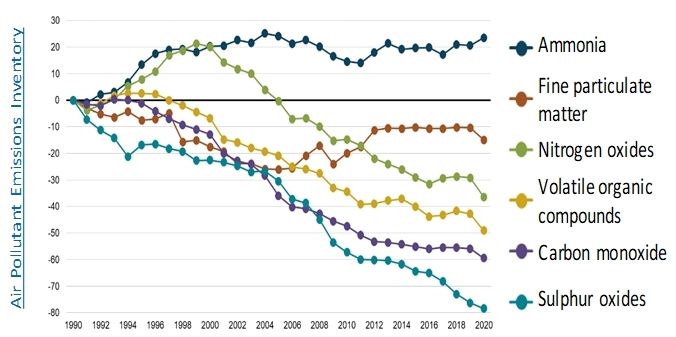
Text description
The graphic demonstrates that pollutant emissions from Ammonia have gradually risen from 1990 to 2020, shown in a dark blue line. On the other hand, pollutant emissions for fine particulate matter, shown in a red line, nitrogen oxides, shown in a green line, volatile organic compounds, shown in a yellow line, carbon monoxide, shown in a purple line, and sulphur oxides, shown in a turquoise line, have steadily declined from 1990 to 2020Major areas of work
- Developing air quality standards and emissions requirements pursuant to the Air Quality Management System
- Developing regulations and other instruments to limit emissions from industry, vehicles, engines, fuels, and products
- Communicating to help Canadians reduce the risk of exposure through the Air Quality Heath Index and related messaging
- Engaging internationally to protect the ozone layer, reduce transboundary air pollution, and address short-lived-climate pollutants
- Investing in scientific research and monitoring on air pollutants to inform policy and regulatory decision making
Priority targets and commitments
Commitments toward ensuring Canadians have clean air:
- Strengthening air pollutant regulations for vehicles and engines (Emissions Reduction Plan)
- Delivering the renewed federal agenda to strengthen and develop control measures for VOC emissions from consumer and commercial products
- Reducing emissions of methane and black carbon in line with Canada’s Strategy on Short-Lived Climate Pollutants and Faster and Further: Canada’s Methane Strategy
- Developing GHG regulations to reduce the combustion of fossil fuels, which will also reduce air pollution
Canadians have clean water
Water pollution affects every facet of life, causing risk to human health, the environment, and economic productivity.
Pollution of all kinds disproportionately impacts Indigenous Peoples and marginalized communities.
Context
- There are significant threats to freshwater quality in Canada, which can vary regionally in nature and magnitude
- Each year, the National Environmental Emergencies Centre receives ≈2000 notifications of oil spills to fresh/marine water
- In Canada, 2-3 million tonnes of material is disposed of at sea every year
Trends in fresh water quality, Canada, 2002 to 2019
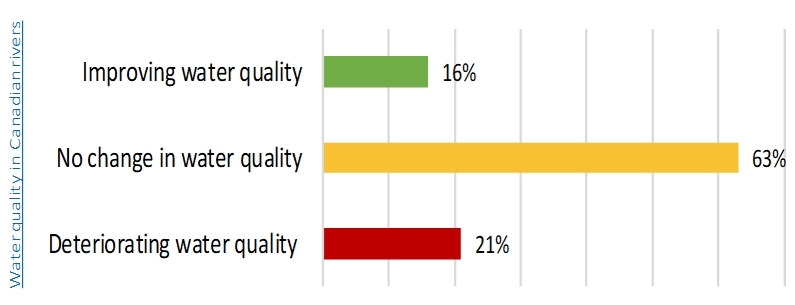
Text description
The bar graph shows that 16% of communities demonstrated improved water quality and has a green bar demonstrating that percentage, 63% of communities demonstrated not change in water quality and has an orange bar demonstrating that percentage, and 21% of communities demonstrated deteriorating water quality and has a red bar demonstrating that percentage.
Major areas of work
- Developing, modernizing,and implementing legislation and regulations to control water pollution, through the Fisheries Act and Canadian Environmental Protection Act
- Investing in scientific research and monitoring on pollution in aquatic ecosystems to inform decision-making by governments and stakeholders
- Coordinating with PTs, Indigenous organizations, and stakeholders on the management of water resources
- Restoring and protecting water quality and aquatic ecosystem health
Priority targets and commitments
Commitments to ensure Canada’s water resources are clean and well-managed:
Fresh water
- Creating a Canada Water Agency and modernizing the Canada Water Act ($43M: Budget 2022)
- Sustaining the Freshwater Action Plan ($19M: Budget 2022)
- Investing in freshwater science and research ($25M: Budget 2022)
- Developing new regulations for coal mining and oil sands effluent and modernizing Pulp and Paper Effluent Regulations
Oceans
- Renewing and expanding the Oceans Protection Plan ($2B: Budget 2022)
Canadians have a clean environment
Solid waste pollution and chemicals can cause harm to human health and the environment. If not managed, they can lead to air emissions, land disturbance and water pollution.
Pollution of all kinds disproportionately impacts Indigenous Peoples and marginalized communities.
Context
- Each year, over 4.3 million tonnes of plastic waste is thrown away in Canada, only 9% is recycled, and without action the lost economic value of unrecovered plastic could be $11.1 billion by 2030
- Canada has thousands of unremediated federal contaminated sites
- ≈500 new substance notifications/year and ≈30 existing substances assessed and managed per year
Fate of Canada’s Plastic Waste, 2018
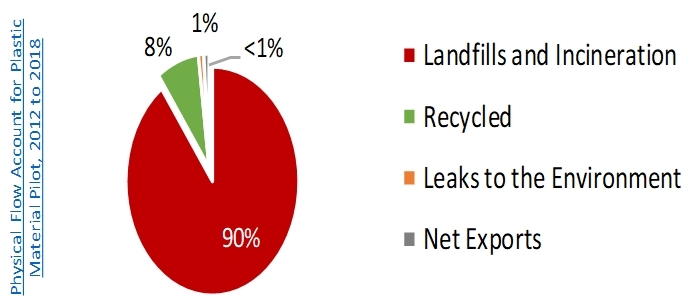
Text description
The pie chart shows that 90% ends up in landfills or incineration and is in white text on a red background, 8% is recycled and the section is displayed in green, and 1% ends up in the environment and the section is displayed in orange, and less than 1% is exported, and the section is displayed in grey.
Major areas of work
- Implementing the Chemicals Management Plan to limit risks to human health and the environment
- With provinces and territories, advancing the Canada-wide Strategy on Zero Plastic Waste to achieve zero plastic waste by 2030
- Investing in science to understand environmental and health impacts of plastics, chemicals, and other solid wastes
- Administering the Federal Contaminated Sites Action Plan to prioritize clean up of sites with greatest risk
Priority targets and commitments
Commitments on plastics, foundational legislation, chemicals management, and environmental justice:
- Investing in science, regulatory measures, and sector solutions to reduce plastic waste and increase circularity ($183M: Budget 2022)
- Strengthening the Canadian Environmental Protection Act to protect Canadians and the environment from harmful substances (Mandate letter commitment)
- Prioritizing clean-up of contaminated sites in areas where Indigenous Peoples, racialized and low-income Canadians live (Mandate letter commitment)
- Supporting legislation to require the development of an environmental justice strategy (Mandate letter commitment)
- Developing strategies to prevent risks from classes of substances and products, and support informed substitution
Overview of programs
1. Water pollution (Fisheries Act)
- ECCC is the lead for pollution prevention under the Fisheries Act
- Prohibits deposit of deleterious substances (pollution) into waters frequented by fish unless authorized by regulation
- Ongoing application of general prohibition to all unregulated sectors and activities, and administration of regulations:
- Pulp and Paper Effluent Regulations (1992; modernization underway)
- Wastewater Systems Effluent Regulations (2012)
- Metal and Diamond Mining Effluent Regulations (2018)
Current issues
- New regulations and approaches under development:
- Coal mining effluent
- Oil sands mining effluent
- Northern Wastewater Systems
2. Air quality
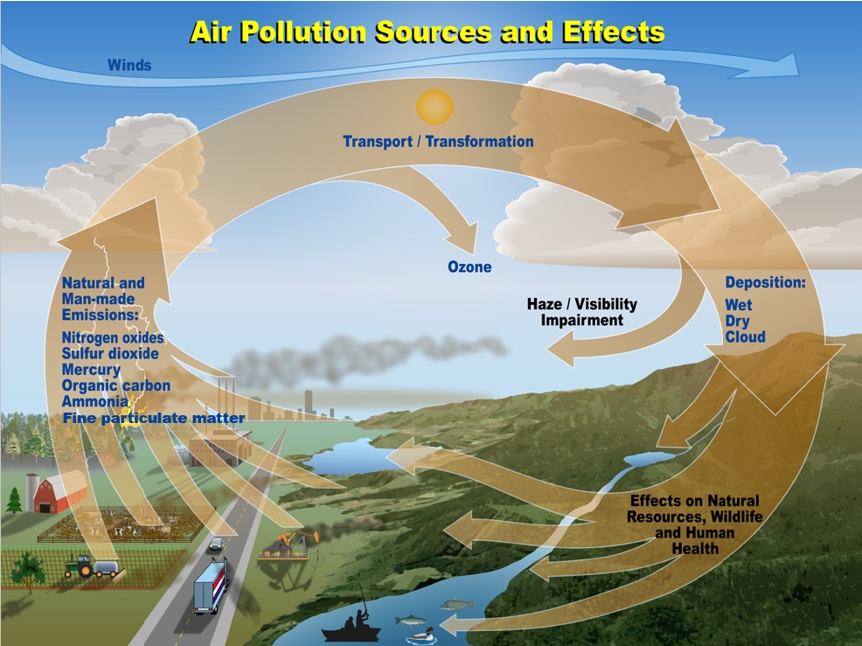
Text description
This is an illustration describing how pollution from human-generated and natural sources is often created in one place and transported through the air to impact human health and the environment.
The title of the illustration, in yellow at the top, is Air Pollution Sources and Effects. The illustration shows a landscape covered with a large orange arrow that moves up and down in a half circle from left to right with some sub-arrows to show the process from the sources of emissions to its effects.
The large arrow starts on the left with the blue text reading: Natural, and Man-made Emissions: Nitrogen oxides, Sulfur dioxide, Mercury, Organic carbon, Ammonia, Fine particulate matter. On the left side, the illustration includes images of different sources of natural and man-made emissions: a forest fire with smoke, a city, an industrial plant, a farm with cattle and a tractor spraying pesticides, a road with traffic, and an oil well.
The arrow goes up on the landscape to show the travelling emissions and that chemical reactions in the atmosphere change pollutants before they are deposited. The blue text, at the top of the curved arrow, reads: Transport / Transformation. Winds are also identified in blue text in the sky of the landscape as a contributing factor to the transportation of pollutants. In addition, two of the sub-arrows show that pollutants in the air can create haze, making it harder to see, as well as ground-level ozone, which is known to have significant effects on human health.
The next section of the orange arrow, on the right side of the illustration, show under what form the pollutants deposit on the ground. The blue text reads: Deposition: Wet, Dry, Cloud.
Finally, on the bottom right of the landscape, the large arrow ends with multiple sub-arrows showing the multiple effects of air pollution. The black text reads: Effects on Natural Resources, Wildlife and human Health. The arrows point to a river, a lake, two fishes, a duck, mountains and grounds as well as humans fishing in a canoe.
- Work with HC and NRC to address outdoor and indoor air pollution under the Air Quality Program
- Work with P/Ts to implement Air Quality Management System (AQMS):
- Ambient air quality standards; Industrial emission limits for certain sectors and equipment; P/T air zones and federally managed airsheds to manage transboundary pollution; Mobile sources; reporting on state of the air
- Regulations for industry, vehicles, engines, fuels, consumer/commercial products and various industrial sectors
- Ongoing implementation and administration of vehicle, engine and fuel regulations, including regular reporting and publication of data
- Work under the Convention on Long-range Transboundary Air Pollution (Air Convention) and the Canada–U.S. Air Quality Agreement (AQA) to address transboundary air pollution
- Work on short-lived climate pollutants, which both affect air quality and have climate warming impacts.
Current issues
- *Redacted*
- Work to resolve impasse at CCME on developing new ambient standards for PM2.5
- Continue to demonstrate international leadership as part of the methane strategy
3. Chemicals Management Plan (CMP)
- Operates largely under CEPA, managed jointly with Health Canada.
- Addresses health or environmental risks from wide range of substances.
- Science-based decision making grounded in research, monitoring, information gathering and risk assessments.
- Risk management measures (wide range of instruments, including regulations and pollution prevention plans).
- 23,000 existing substances in use between 1984 and 1987 were screened for risks and 4300 identified for further assessment and risk management as needed.
- Assessments of these 4300 largely completed.
- Assessment and management of 500 new substances every year.
Current issue
- Program needs to evolve
- Passage of CEPA reform Bill (S-5) and need to renew CMP funding will create opportunity/need to develop vision and goals for modernized CMP
- A modernized program could address, for example, chemicals in products, alternatives, vulnerable populations, occupational exposure, and informed decision-making (labeling)
4. International engagement on chemicals and waste
- Domestic efforts alone are not sufficient to effectively protect the health and environment of Canadian from risks that originate beyond our borders
- While long-range environmental transport is still a concern, our attention has also turned to risks via trade. Canada may be a small market with limited influence, but larger economies struggle with these same issues
- By working with other jurisdictions and organizations we are able to advance science, fill data needs, access best available science and develop internationally recognized approaches to make better informed decisions, to strengthen protections for Canada while also advancing sound management of chemicals and waste around the world
- Canada is a Party to
- five global, legally binding, multilateral environmental agreements (MEAs) focussed on chemicals and waste: Basel Convention, Rotterdam Convention, Stockholm Convention, Minamata Convention, Montreal Protocol
- Regional agreement: UNECE Convention on Long Range Transboundary Air-Pollution
- a voluntary, multi-stakeholder and multi sectoral policy framework: Strategic Approach to International Chemicals Management (SAICM and its successor),
- international organizations, initiatives and scientific/ technical bodies: UNEP Science-Policy Panel on Chemicals, Waste and to Prevent Pollution, OECD Working Party on Risk Management
- Canada engages in bilateral and regional cooperation - EU, U.S., Australia, others
5. Federal Contaminated Sites Action Plan (FCSAP)
- Established in 2005 to reduce risks to health and environment (federal government liability)
- Whole-of-government approach: 19 agencies, departments, and Crowns work together to assess, remediate and risk manage their contaminated sites (e.g. fuel storage facilities, old dump sites, navigational systems, military bases)
- From 2005 through 2021-22:
- $5.1B spent on the assessment and remediation of the highest risk sites
- Assessment and remediation activities at over 12 000 sites
- Program was renewed for 15 years (2020 to 2034)
- Budget 2019 provided $1.16 B for Phase IV, from 2020 to 2024
Current issues
- *Redacted*
- Enhancing Indigenous engagement and participation
6. Waste management
- ECCC regulates and tracks transboundary movement of hazardous waste and hazardous recyclable material via the Cross-border Movement of Hazardous Waste and Hazardous Recyclable Material Regulations under using CEPA regulations.
- Canada is a Party to international instruments with requirements for controlling export, import and transit of certain waste.
- Basel Convention transboundary movements of hazardous waste and their disposal)
- OECD Decision (recyclables in the OECD)
- Canada-USA Agreement (because US is not a Party to Basel)
- Canada-USA Arrangement on non-hazardous waste
Current issue
- Enhance collaboration with partners to reduce illegal exports of waste.
- In the process of ratifying the Ban amendment under the Basel Convention (will require reg amendments)
7. Marine programs
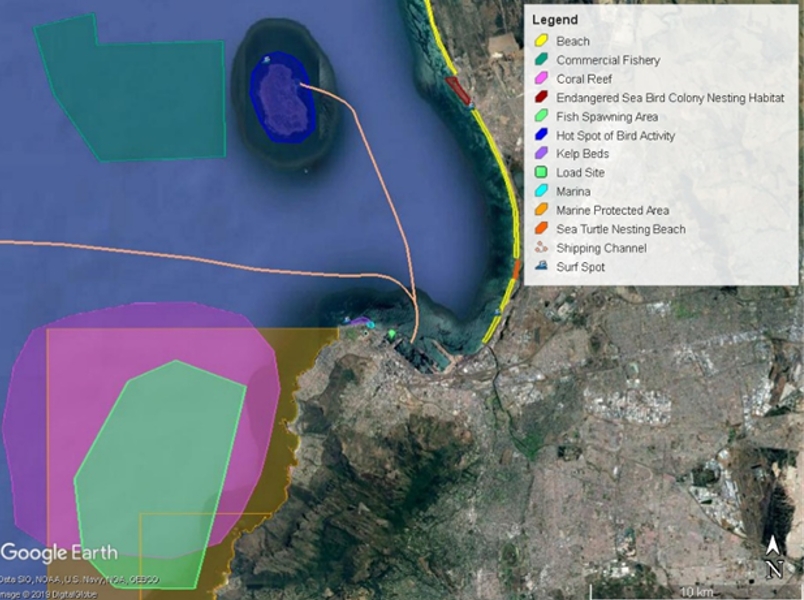
Text description
The figure shows an aerial photograph of a typical coastal region. The photograph is annotated with several geographical constraints that could possibly limit the location of a new disposal site for dredged material. Constraint areas on the aerial photograph include a beach area, a commercial fishery zone, a corral reef, an endangered sea bird colony-nesting habitat, a fish spawning area, a hot spot of bird activity, kelp beds, the dredge material loading site, a marine, a marine protected area, a sea turtle nesting site, shipping channels, and a surf area. The areas of the photo unidentified by these different areas represent the potential areas where the new dredged material disposal site could be located.
ECCC carefully selects suitable disposal sites to avoid harming amenities and causing pollution, and works with other coutries through the London Protocol to see that they can achieve the same level of marine protection.
- CEPA prohibits disposal at sea of substances from ships, aircraft, platforms or other structures.
- Minister may issue permits for disposal of low risk waste (listed on CEPA Schedule 5), such as dredged material or fish processing waste.
- CEPA prescribes rigorous assessment process for decisions to issue disposal at sea permits. (CEPA Schedule 6).
- CEPA’s disposal at sea provisions implement the 1996 London Protocol on the prevention of pollution from dumping of waste at sea.
- The Antarctic Environmental Protection Act implements Canada’s obligations under the Protocol on Environmental Protection to the Antarctic Treaty and ensures Canadian activities in the Antarctic are assessed for potential environmental effects.
Current issues
- Implementation of a collaborative decision making agreement with Tsleil-Waututh Nation in BC
- Add sub-seabed CO2 sequestration to Schedule 5 of CEA and develop permitting regime
- Develop a position on the regulation of marine geoengineering activities
- Regulations to remove overlap between CEPA and DFO’s Aquaculture Activity Regulations
- Canada’s request to become a Consultative Party to the Antarctic Treaty
- Revise the cost recovery program for disposal at sea permits
8. Zero Plastic Waste

Text description
A waterbody and rocky shoreline with fivepictograms to depict circular solutions as part of the Ocean Plastics Charter and Canada’s zero plastic waste agenda: 1) a head with gears; 2) chasing-arrows symbol; 3) a hand holding a globe; 4) a microscope; and, 5) a hand removing a plastic bottle from water.
- 1st phase (2019-22) - $64 million Federal Leadership Towards Zero Plastic Waste in Canada
- 2nd phase (2022-27) - $210.9 million Advancing a Circular Plastics Economy for Canada to be delivered by ECCC, CIRNAC, DFO, HC, NRC, StatCan, TC
- ECCC priority work areas, which include activities under the CCME:
- Science – $82.1M for ECCC, CIRNAC, HC, NRC, StatCan
- Regulations – $65.7M for ECCC, HC
- Innovation – $16.4M for ECCC
Current issues
- Coalition of plastic manufacturers has applied for two judicial reviews, challenging:
- CEPA Schedule 1 listing of “plastic manufactured items”
- Publication of the Single Use Plastic Prohibition regulations
- Developing regulations on recycled content, recyclability and compostability labelling
- Federal plastics registry in development
- Ongoing negotiations on a legally-binding global agreement on plastic pollution for 2024
- Unfunded mandate letter commitment (ISED, ECCC): Infrastructure & innovation fund to scale-up and commercialize technologies and solutions for reuse and recycling
9. Environmental emergencies
- Environmental Emergency Regulations provide authority on the prevention of, preparedness for, response to and recovery from environmental emergencies at facilities.
- The National Environmental Emergencies Centre (NEEC) is one of ECCC’s critical services, operating 24/7. For ECCC responding to an environmental emergency entails:
- Managing a 24/7 notification system
- Overseeing and monitoring response efforts by the responsible party
- Providing scientific and technical advice (spill trajectory modelling, weather, wildlife, shoreline cleaning methods)
- Authority to require that all reasonable and appropriate measures are takenand to take action, if needed
- NEEC managers close to 40,000 environmental emergency notifications year.
- Ocean Protection Plan (OPP) ) 2.0 –.ECCC will invest $239M over 9 years (2022-23 to 2030-31) to protect, preserve, and restore Canada’s oceans and waterways and strengthen marine research and science.
Current issues
- Amend CEPA and other federal legislation to allow use of Alternative Response Measures – to expand tools available to manage and clean oil spilled from ships, offshore exploration and production, and federally regulated pipelines.
- Develop Canadian position on the proposed OECD Decision-Recommendation concerning chemical accident prevention, preparedness and response instrument by Spring 2023.
10. Environmental assessment
- EPB is focal point for the provision of ECCC scientific information, knowledge and advice regarding a proponent’s characterization of effects and the efficacy of mitigation measures, as required by the Impact Assessment Act (IAA), and other EA regimes (e.g. CEAA 2012, Territorial Boards).
- Federal Authority on effects within federal jurisdiction including: climate change, biodiversity (focused on migratory birds and species at risk), air quality, water quality, environmental preparedness and emergencies.
- Leads Government’s approach to cumulative effects through collaboration with external and internal partners and provides strategic advice to the Open Science and Data Platform (OSDP) for Cumulative Effects
Environmental protection bills (currently in parliament)
- Bill S-5 introduced February, 2022.
- Focused on modernizing CMP and recognizing right to a healthy environment under CEPA.
- First time CEPA reform bill tabled since Act came into force + 20 years ago.
- Now with Standing Committee on Environment and Sustainable Development (the ENVI Committee); clause-by-clause study ongoing.
- Identical to Bill C-28, which died on Order Paper in 2021.
- Private Member’s Bills on various topics.
- Bill C-226 - National Strategy Respecting Environmental Racism and Environmental Justice Act (previously Bill C-230 [Lib.]).
- Bill S-234: An Act to amend CEPA (final disposal of plastic waste) (previous Bill C-204 [CPC]).
- Bill C-219: Canadian Environmental Bill of Rights
Key partners
Key federal partners
- Health Canada
- Fisheries and Oceans Canada / Canadian Coast Guard (DFO/CCG)
- National Research Council (NRC)
- Natural Sciences and Engineering Research Council (NSERC)
- Agriculture and Agri-Foods Canada (AAFC)
- Transport Canada
- Natural Resources Canada (NRCan)
- Industry, Science and Economic Development (ISED)
- Treasury Board
- Justice
Other partners include
- Provinces and territories:
- Canadian Council of Ministers of the Environment (CCME)
- CEPA National Advisory Committee (NAC)
- Bilateral discussions and arrangements
- Indigenous communities and organizations
- Industry
- Academia
- Environmental and health NGOs
Ongoing challenges
- Coordination with GHG mitigation agenda
- Identifying co-benefits
- Managing cumulative regulatory burden
- Improving integration of climate and air policies to avoid unintended consequences
- Managing international impacts
- Foreign impacts on Canada
- Transboundary air pollution (incl. Short-Lived Climate Pollutants, Persistent Organic Pollutants)
- Content of imported products
- Canadian impacts on other countries
- Transboundary mining
- Canada-US air pollution.
- Foreign impacts on Canada
- Capacity to manage and digitize regulatory data
- To reduce regulatory costs
- To inform decision-making
- To increase information to Canadians
- Indigenous engagement
- Consultation fatigue, capacity and funding
- Alignment with overall agenda on reconciliation and implementation of UNDRIP
- Developing and implementing legislative initiatives stemming from or implicating ECCC Minister
Supplemental briefings
Key topics to be discussed:
- Climate change mitigation
- Zero plastic waste
- Chemicals Management Plan
- CEPA reform
